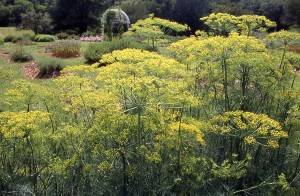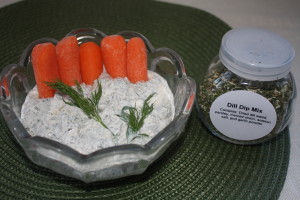Dill (anethum gaveolens)is a hardy annual and one of the easiest herbs to grow. It can be planted indoors and well as outside in cool weather. Try the variety ‘Bouquet’ for a high leaf yield.
Ancient Egyptians recorded dill as a soothing medicine, and the Greeks used it for hiccups. Dill was brought to America by the early settlers. The children would chew on the seed during long sermons.
The herb obtained its name from the Old Norse word ‘dilla’, which means to lull. Today herbalist still used it for colic babies, and is used commercially to scent soaps
Dill likes full sun, protected from the wind, and the soil should be rich and well drained.
Sow in the seed directly in the ground a couple weeks for the last frost. Cover the plants with light dusting of compost. Keep moist until germination which should be about 10-15 days. Plant every couple of weeks for continuous crop. Seeds can be stored for 3-10 years and should remain viable. Store the seeds in the refrigerator in an envelope and label with year and variety.
Dill grown in pots need room for deep roots and room for stakes, and can grow up to 3 feet tall. Fennel, dill and carrots all compete for moisture, so it is good idea to plant in different areas.
Black swallowtail larval love to feast on fennel and dill, so don’t be surprise if the plants are stripped down to the stem. Parsley can also be host to butterflies. It is good idea to sew dill seeds in different parts of the garden and enough to share with the butterflies. The plants should be spaced 10-12” apart.
Harvest the leaves when young, pick the flowering tops just as fruits begin to form and gather the seeds after flowering head turns brown. To collect seeds hang the seed head over a cloth to collect the seeds.
Dry or freeze the leaves or used in herbal vinegar. When making vinegar add the flowering seed heads to a sterilized canning jar and cover with apple cider or white wine vinegar. Allow to set for two weeks. Strain out the plant material and use a bottle with cork or plastic lid. Metal will react to the vinegar.
Use the whole seed or ground in soups, fish, cabbage, pies, dill butter, breads and of course pickles.
The crushed seed can be infused as a nail strengthening bath. Chew the seeds to sweeten breath.
Dill is rich in mineral salts, and is good for indigestion, flatulence, hiccups, stomach cramps, insomnia and colic. Infuse ½ ounce crushed seeds in 1 cup of boiling water, strain. Add one tablespoon to water for best results.
Do not confuse the plant with the water hemlock and position hemlock. They are part of the same family Apiaceae.
Dill Cucumber Salad
¾ c. sour cream
1 small clove garlic, crushed
1 tsp. honey or Stevia to taste
½ tsp. salt
¼ tsp. pepper
¼ tsp. dried dill weed or 1 tsp. fresh
2 med cucumber, thinly sliced and seeded
Mix sour cream, garlic, honey, salt, pepper, and dill weeds. Stir in cucumbers and sprinkle with fresh dill.
Dill Dip Mix
¼ c. dried dill weed
2 tsp. garlic powder
¼ c. dried minced garlic
¼ c. dried minced parsley
2-3 tsp. season salt
Mix and store in airtight container.
To make the dip:
½ c. sour cream
½ c. mayonnaise
1-2 Tbsp. dill dip mix
Mix all ingredients together and chill for several hours. Garnish with fresh dill and parsley.
Hope you enjoy these recipes and have fun growing dill.



